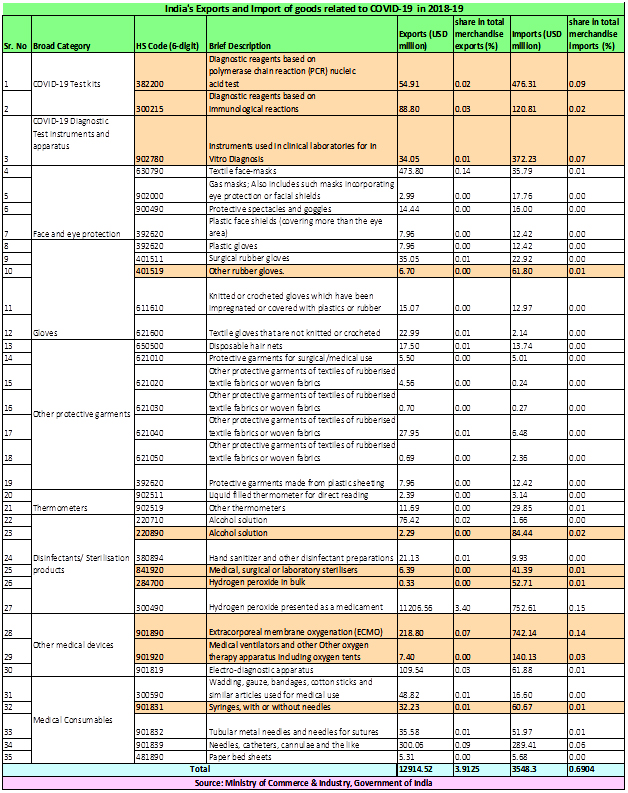India can save upto USD 3.5 billion of foreign exchange annually by promoting local manufacturing of key medical goods that it currently imports and which are critical to combat COVID-19 disease. In 2018-19, India imported USD 3.5 billion worth of these medical goods, that are classified broadly across nine categories. These categories include disinfectants, medical testing kits, diagnostic instruments & apparatus, face & eye protection items, gloves, other protective garments, thermometers, medical consumables and other medical devices.
Specifically, India can save USD 742 million annually by becoming self-sufficient in manufacturing a kind of life support device, that is scientifically called Extracorporeal membrane oxygenation (ECMO). This device provides prolonged cardiac and respiratory support to patients by artificially removing the carbon dioxide and oxygenating red blood cells. Besides this device, India annually imports USD 140 million worth medical ventilators and other oxygen support apparatus.
India buys USD 597 million of medical test kits from foreign suppliers, which can be avoided by creating indigenous manufacturing capacity. Similarly, India is also an importer of syringes, needles, catheters and other medical consumables worth USD 424 million annually. The country buys USD 112 million worth of gloves, made or rubber, textile, plastics and other materials from other countries.
Speaking about the potential for local manufacturing of these goods, Ms. Rupa Naik, Senior Director, MVIRDC World Trade Center Mumbai said, “India is already a net exporter of these goods, suggesting that India has competitive advantage in producing these goods. The present crisis should be used as an opportune time to mobilize domestic resources and rethink our import dependence for some of these goods.”
India exports USD 12.91 billion worth of these nine category of medical goods annually, while it imports USD 3.5 billion worth of these goods, thereby running a trade surplus of USD 9.36 billion. The detailed list of these goods exported and imported by India in 2018-19 is given in the following table.

APIs, Hydroxychloroquine
In the wake of the COVID-19 outbreak, India imposed restriction on export of active pharmaceutical ingredients, their formulations, diagnostic kits and the anti-malarial drug hydroxychloroquine. Recently, India reversed some of these decisions by allowing export of 24 drugs [also called active pharmaceutical ingredients (APIs) and their formulations] as any restriction on shipment would hurt the earnings of most pharmaceutical companies. India also agreed to allow export of hydroxychloroquine on case-to-case basis to select countries.
In 2018-19, India exported USD 15.3 billion worth of these goods cumulatively, while it imported USD 4.1 billion worth of these goods. Thus, India can also explore domestic manufacturing of these goods to save USD 4.1 billion foreign exchange. In this regard, the central government’s recent decision to promote three mega bulk drug parks by providing financial support for common infrastructure facilities is a welcome move.
The following table provides export and import of these goods in 2018-19

Tariff on Imports
India has already imposed high tariff on medical goods, suggesting less room for further increasing tariff to discourage imports. India’s average applied MFN tariff for medical goods stands at 11.6%, compared to the world average of 4.8% (Source: WTO). India imposes 15% average MFN tariff on medical supplies (which includes disinfectants, needles, syringes, test kits, bandages etc.), while the corresponding world average tariff is 6.2%. For respirators, India imposes an import duty of 10%, while China imposes 4% (Source: WTO) . Around 67 member countries of WTO have waived duty on respirators or ventilators and they include European Union, USA, Republic of Korea, and Switzerland.
Therefore, the only way to encourage local manufacturing of these goods is development of indigenous technologies, creating quality standard norms and developing an ecosystem of ancillary vendors.
Global Trend
Currently, India does not figure in the top 10 exporters of medical products (which include medicines, lab equipments, personal protective equipments and consumables). Germany, USA, Switzerland and Netherlands are the top four exporters of these products in the world.
Currently, China, Germany and USA supply 40% of personal protective equipments to the world, while more than 50% of respirators and ventilators are supplied jointly by Singapore, USA, Netherland and China.
However, the interesting thing to note is that almost all the top 10 medical goods exporting nations are also the top importers of these goods, thereby suggesting that a country cannot attain complete self-sufficiency in these goods. For example, Germany and USA are not only top two exporters but also the leading two importers of medical goods. Netherlands, which is the fourth largest medical goods exporter, is also the fifth largest importer of these products. Ireland is the only top 10 medical goods exporter that does not figure in the top 10 list of importing countries of these products.

 : +91 7718886506
: +91 7718886506